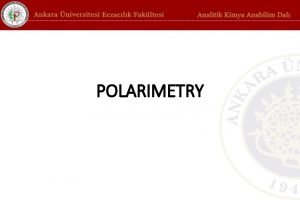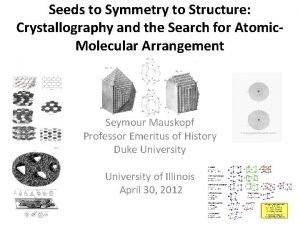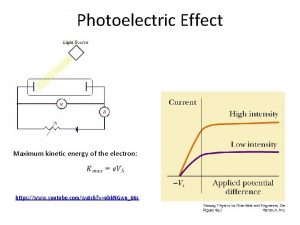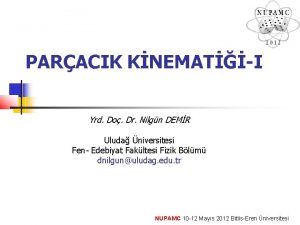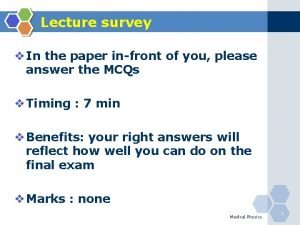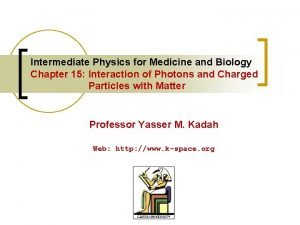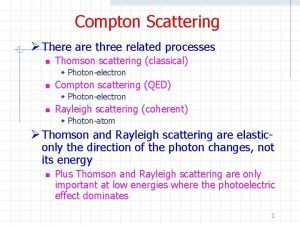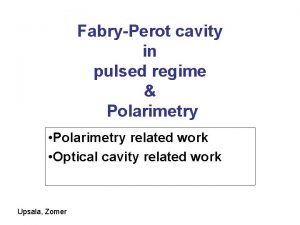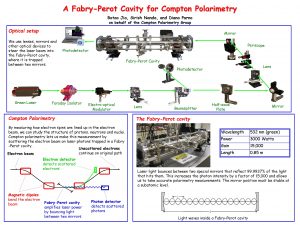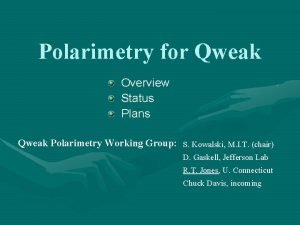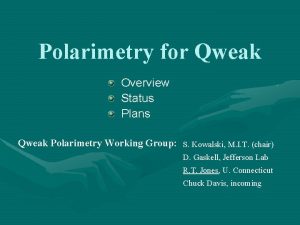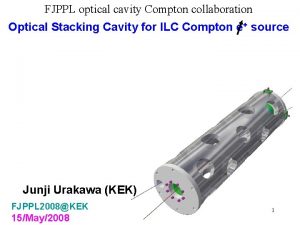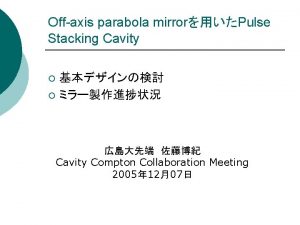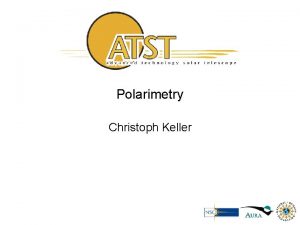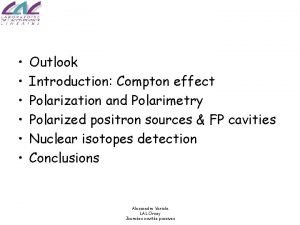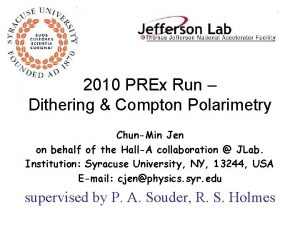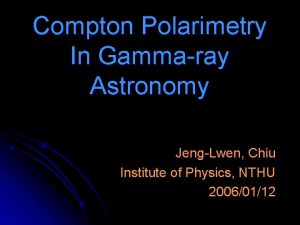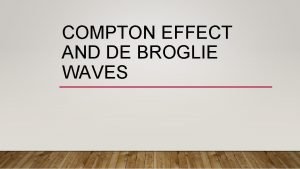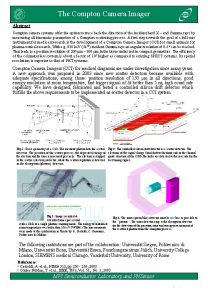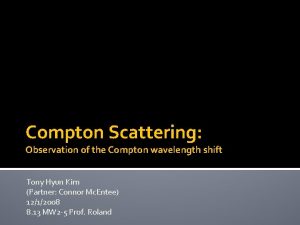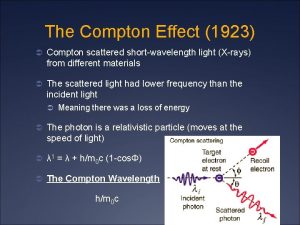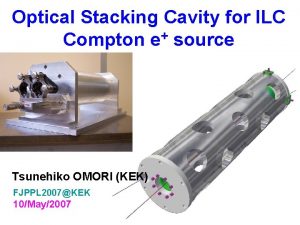COMPTON POLARIMETRY Collected data Cavity power Status on




















- Slides: 20

COMPTON POLARIMETRY • Collected data • Cavity power • Status on counting methods • Systematic errors and hardware issues

Collected Data Good Runs Ebeam (Ge. V) k’Max (Me. V) <A>int (%) AMax (%) 4 He ~450 2. 76 129 2. 3 4. 8 LH 2 ~450 3. 18 171 2. 7 5. 5

Cavity Power • Laser power supply changed in June, tested OK: 1200 W • Down to 300 W few days before the experiment • Incident laser power still nominal • Laser beam waist measured in agreement with simulation • Alignment optimized • Back to 500 W after optics cleaning • Slow exponential decay of cavity power seen during part of the run • Cavity mirrors? Two finesse measurements so far, differ by a factor 2 to be done again…

Counting Analysis Differential 650 mm strips 4. 5 mm gap Pb. W 04 Semi-integrated

Calibration e- Detector Ee- Position of the Compton edge calibrates the detector and determine the vertical gap Ydet. DPe/Pe ~ 2 DY/Y Can use the rate or the asym spectra. Discrepancy taken as syst error. DY=200 mm DPe/Pe = 3. 5% @ 3 Ge. V Ee- a Bdl, lever arm after D 3 (~4. 1 m)

Calibration e- Detector Comtpon+Background S/B Compton edge position sensitive to beam motion (coil pulsing) Extracted Ydet is always underestimated

Calibration e- Detector • Fit of the asymmetry spectra of the 4 planes is more robust because it uses information from all strips. • Systematic error could be pinned down by simulation • Stringent cross-check available on line…

Calibration cross-check • The response function of the g detector is determined using the e- det as an energy tagger reference run. • When fitting the photon spectrum, l corrects for gain drift and error in the e- det calibration. expect l=1 for the fit of the reference run itself l-1 = 10 -4 !! Had to correct for the fact that mstrip planes are 1 cm appart and use survey data for the lever arm after dipole 3 (4. 11 m instead of 4. 10)

Photon Analysis No dependence on the software threshold over a wide range Systematics of the response function under control.

Comparison e- - g 03/08/05 19/09/05

Comparison e- - g 15/10/05 01/11/05

Laser Polarization

Laser Polarization

Laser Polarization e- and g data are not compatible origin found to be electronic pickup: ADC pedestal changes by 4 channels depending on the cavity state! Wasn’t there last year… Could be due to logical signals of cavity ON/OFF, Left/Right present in several electronic crates? Easy to test.

Laser Polarization After pedestal correction, all analysis are compatible at 1 s level. Compton polarimetry is a tedious way to check pedestal correlations… The correction doesn’t affect the mean value, but reduces the Left Right discrepancy. Left laser polarization is ~0. 6% lower than Right polarization?

Laser Polarization La ser CIP Tran sfer Ex it Monitoring of the laser polarization downstream the cavity Li ne l/4 plates Fun ction

l/4 Scans Integrating Sphere S 1 TM pol. state 8. 86 9. 86 TE pol. state x Slow Wollaston Prism b x y Rotatable l/4 plate Incoming Polarization Ellipse Integrating Sphere S 2 y Stokes Parameters: P 0, P 1, P 2, P 3

Laser Polarization • 30 l/4 scans performed during helium run. • We do find a 0. 5% difference in laser polarization states but with opposite sign Need to check the Left-Right definitions in both analysis… Accumulated cavity power: Left state = Right state at few % level (~500 W)

Conclusion ØSignificant improvements in the counting analysis Best agreement between the two methods ever achieved On track for 2% accuracy or better. ØHardware issues: compton is getting old… • Should revise all cabling at some point • Need cross-talk study before GEn starts • Numerous « end of run failed » remove 600 Hz part of the aquisition? • Cavity power is low? How long before very low?

Systematic Errors Counting photon Source Last Year To Do Expect. Pg 0. 70% Open cavity? 0. 7%-1% Resp. Func. 1. 25% Ana. +Simul. 1. 1% Dead Time 1. 00% - ~0% Pile up 1. 00% Simulation 0. 5% Rad. Corr. 0. 25% - ~0% TOTAL 2. 0% 1. 4%-1. 6% Counting electron Expect to reduce syst. error as well because of better calibration. (3. 5% for now)
 Thoracic membranes
Thoracic membranes Polarimetry definition in chemistry
Polarimetry definition in chemistry Biots law polarimetry
Biots law polarimetry Polarimetry organic chemistry
Polarimetry organic chemistry Example of qualitative vs quantitative
Example of qualitative vs quantitative Chapter 7 2 body planes directions and cavities
Chapter 7 2 body planes directions and cavities Mental anatomical term
Mental anatomical term Ligaments stomach
Ligaments stomach Omental foramen
Omental foramen Power triangle formula
Power triangle formula Scientists recently discovered that rocks collected
Scientists recently discovered that rocks collected How are ballistics collected
How are ballistics collected Advantages of scanning and skimming
Advantages of scanning and skimming He is dreaming (george)
He is dreaming (george) Compton scatter radiology
Compton scatter radiology Photoelectric
Photoelectric Compton saçılması
Compton saçılması Photoelectric and compton effect
Photoelectric and compton effect Compton effect
Compton effect Compton olayi
Compton olayi Photoelectric and compton effect
Photoelectric and compton effect

